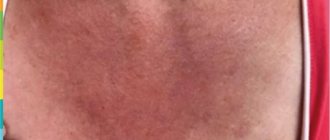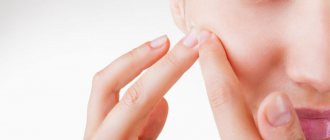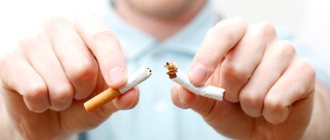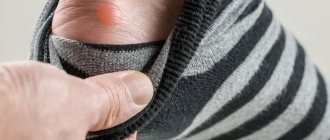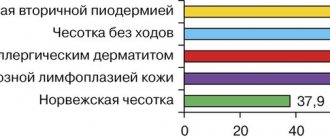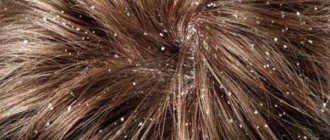Hidradenitis - what is it? Photos, causes and treatment at home
Hidradenitis (popular name - knot udder) is an acute inflammatory disease of the sweat glands. All sweat glands in our bodies are heterogeneous and have variations in their structure and location.
With hidradenitis we are talking about the so-called apocrine glands. They are located in the genital area, external anus, and ear canal, but are most concentrated and affected in the axillary areas. These are quite large formations that produce sweat fluid or sweat, the chemical composition of which is characterized by high concentrations of lipids and, in particular, cholesterol. The active secreting cells of such glands often end up in the sweat fluid themselves.
Causes
The main cause of the disease is Staphylococcus aureus and white.
- When bacteria penetrate into the excretory ducts of the sweat glands, they begin to multiply.
- The sweat gland duct is blocked by a horny plug.
- the produced secretion, which has no outlet to the outside, stretches the gland.
- the accumulated secretion is a good breeding ground for bacteria to multiply.
- the sweat gland becomes inflamed and the duct ruptures.
- the infection spreads to surrounding tissues. Fistula tracts are formed.
However, the entry of staphylococcus occurs only in the presence of predisposing factors:
- increased sweating;
- the presence of microtraumas to the skin resulting from careless shaving or scratching;
- weakening of the body's defenses (decreased immunity);
- failure to comply with personal hygiene rules;
- endocrine diseases such as diabetes mellitus, exogenous constitutional obesity.
Hidradenitis, localized in the armpit, occurs more often in women than in men. In old age, the occurrence of hidradenitis practically does not occur, since at this age the sweat glands no longer function well.
Symptoms over time
As hidradenitis develops, swelling appears on the skin at the site of formation of purulent nodes. The skin acquires a bluish tint (this is clearly visible in the photo of hidradenitis in women in the groin), and the painful sensations intensify. Soon the central part of the nodes softens and opens like a boil.
Classification
There are several forms of axillary hidradenitis:
- Acute purulent form. The pathology develops due to blockage of the apocrine sweat and sebaceous glands. Among patients with this form of the disease are people who do not take good care of their armpits. Hidradenitis in this form occurs as a typical inflammation in the body: low-grade fever, sometimes rising to 38 degrees, malaise, discomfort, developing into pain in the armpits. The purulent form is life-threatening for the patient if he does not seek treatment from a doctor.
- Chronic hidradenitis is more often called a recurrent form, which is characterized by a purulent process that lasts a long time. The disease often appears at regular intervals with an acute purulent phase. The area of apocrine glands affected by inflammation increases. Lack of treatment for purulent processes is dangerous due to septic consequences, threatening the life of the patient.
- If you take sufficient care of your armpits, but do not shave carefully, the delicate skin of this area may become injured. Staphylococcal or other types of pathogenic microflora get into scratches and wounds. Hidradenitis nodosa begins to form, tending to develop into purulent if left untreated.
Like hidradenitis inguinalis, axillary develops through stages over 10 days.
1.General information
The complex structure and largest human organ in area, that is, the skin, is replete with all kinds of superficial glands, sebaceous and sweat. They provide an optimal level of hydration, participate in the removal of harmful compounds and waste metabolic products, and are also responsible for adaptive thermoregulation in response to changes in external conditions. Some of these skin glands - and there are several million of them on the human body - function continuously throughout life; These are, for example, eccrine sweat glands, which, if necessary (or in the presence of any pathology accompanied by hyperhidrosis), can produce up to 10 liters of sweat per day. Another group of sweat glands, the apocrine ones, are inactive as unnecessary in childhood and old age, but with the onset of puberty they begin to intensively perform one of the important evolutionary functions: to produce a secretion with a purely individual odor, attractive to the opposite sex and serving as one of the calling cards in the never-ending race for procreation. By the way, the own smell of clean, healthy skin, even after physical exertion, is relatively weak and piquant; otherwise, you should think, first of all, about personal hygiene: the secretion of the apocrine sweat glands is quickly decomposed by bacteria, releasing a sharp, unpleasant odor.
Considering the huge number of skin glands, one should not be surprised at the abundance of possible problems with them. The glands can become clogged and clogged, become infected and inflamed, fester and open, often leaving scarring cosmetic defects. Most of these dermatological problems, especially those associated with periods of rapid hormonal changes, are simply annoying, transient (passing without a trace) and relatively harmless. However, in the case of chronicity and generalization, they can pose a real threat to health and even life.
Hidradenitis is a relatively rare form of skin-glandular inflammation, popularly known under the apt name “bitch udder.” This is an infectious-inflammatory process in the apocrine sweat gland, which has a certain specificity both in structure and in secretory biochemistry; Accordingly, hidradenitis differs from blockages, inflammations, abscesses in other glands (sebaceous, eccrine sweat, lacrimal, Bartholin's, etc.) in a number of characteristic features.
A must read! Help with treatment and hospitalization!
Symptoms of hidradenitis
The beginning is gradual. At the site of inflammation, an itching sensation occurs, and a dense, very painful swelling appears with a diameter ranging from a few millimeters to 1-2 centimeters.
Gradually the size of the swelling and pain increase. The skin over it turns purple-red. The center of the swelling gradually softens, opens, and pus begins to be released through the resulting hole. The development cycle of infiltration lasts 10-15 days. Resolution of hidradenitis ends with the formation of a scar. Often neighboring sweat glands are involved in the inflammation process.
In this case, an extensive, very painful infiltrate is formed, the skin over which becomes lumpy. With successive damage to more and more sweat glands, the process drags on for a month or more. Hidradenitis is often accompanied by symptoms of general intoxication, hyperthermia, cephalgia, and leukocytosis.
Complications of the disease
Complications of the disease are:
- Inflammation of the lymphatic vessels and lymph nodes.
- On the side of hidradenitis, lymphedema sometimes develops - swelling of the soft tissues of the upper limb on the side of hidradenitis.
- When inflammation spreads to the subcutaneous tissue, phlegmon develops.
Rice. 8. The photo shows the consequences of hidradenitis under the armpit - hypertrophic and keloid scars.
Rice. 9. At the site of inflammation of the sweat glands under the armpit, ugly, retracted scars often form.
Rice. 10. The photo shows inflammation of the lymphatic vessels, as a result of a boil, carbuncle, abscess or hidradenitis.
Consequences
If hidradenitis is left to chance, hoping for self-healing, or treated inappropriately (including pseudo-methods “from a neighbor”), it can cause a number of complications.
First of all this:
- Lymphadenitis - inflammation of the lymph nodes located nearby (primarily axillary and inguinal) due to penetration of the pathogen into them; further damage to the lymphatic system is fraught with lymphostasis (elephantiasis);
- Generalization (spread) of the process - the pathogen goes “beyond” the sweat glands and spreads throughout the surrounding tissues both in breadth and depth, through connective tissue bridges, tendons, fascia, “flowing” quite far from the primary focus and “dispersing” secondary infectious diseases throughout the body foci; it is especially dangerous if the purulent process affects the periosteum and bone tissue - such a disease is called osteomyelitis; fistulas that are very difficult to treat are formed;
- In advanced cases, blood poisoning (sepsis).
What happens if you don't see a doctor?
If you do not contact a surgeon, the abscess can mature for several weeks. During this time, the cavity will increase, and the general condition will worsen.
In some cases, the pus comes out on its own. But there is a danger that the cavity will become covered with connective tissue from the inside and become a reservoir for infection. In this case, a non-healing fistula is formed, through which the contents of the abscess will flow out. From time to time, hidradenitis will form at this site. Subsequently, rough scars appear, which can limit the mobility of the limbs.
Diagnostics
Diagnosis of hidradenitis begins with a questioning and examination of the patient. This disease is supported by the characteristic area of localization, the appearance of the edema and possible accompanying symptoms. The doctor needs to distinguish damage to the sweat gland from other pathologies with a similar clinical picture. This:
- boil, characterized by the presence of a purulent core;
- carbuncle - an accumulation of several boils in a limited area;
- phlegmon - purulent inflammation of the deep layers of the skin - fatty tissue, sometimes connective tissue is involved in the process;
- complicated atheroma - infection of the sebaceous gland;
- lymphadenitis, inflammation of the lymph nodes.
It is also worth diagnosing another form of hidradenitis suppurative. It develops against the background of severe acne. Seals in the ducts of the sebaceous gland compress the sweat gland, which leads to the onset of the inflammatory process. This type of disease is recurrent in nature, and it is advisable to treat it after eliminating the cause. During lactation, the seals at the initial stage of hidradenitis are also similar to areas of milk accumulation due to blockage of the duct on the nipple.
Treatment of hidradenitis
Begin treatment of hidradenitis under the armpit as early as possible, preferably at the stage of compaction formation. With timely medical care and proper treatment, the infiltrate can resolve at the initial stage.
If pain and a small nodule appears in the armpit, the doctor prescribes local treatment. The affected area and the skin around the infiltrate should be thoroughly treated with alcohol several times a day - this will destroy pathogens present on the surface of the skin and prevent the spread of the pathological process to the sebaceous glands.
A compress with Dimexide is applied to the affected area twice a day. During treatment, the patient should avoid intense physical activity and stress, take care of personal hygiene, and eat light, protein-rich meals.
With the development of hidradenitis suppurativa, antibiotics cannot be avoided. The drug is prescribed only by a doctor, depending on the individual characteristics of the patient’s body, the severity of the disease, age and other factors. Treatment continues for at least 7 days; it is absolutely not permissible to stop the course on your own when improvement occurs or the abscess opens. To accelerate the maturation of the abscess, it is recommended to apply bandages with Vishnevsky ointment or ichthyol.
Mature hidradenitis is treated surgically. The usual opening of hidradenitis suppurativa and its drainage does not bring a positive result. At the same time, many microabscesses remain in the lesion, and their further maturation occurs. Surgical treatment consists of making a wide incision passing through the infiltrate to healthy tissue.
After complete evacuation of the pus, the affected fatty tissue is removed. In case of repeated cases of hidradenitis, radical surgical treatment is required. At its first stage, the purulent focus is opened and the inflamed tissue is excised. After the inflammatory process has passed, the skin and subcutaneous tissue in the affected area are completely removed. The resulting defect is closed with donor skin flaps from the patient himself.
How to treat?
Therapy for hidradenitis is complex. Patients need:
- Follow the general recommendations of the doctor, in particular regarding diet, body care and strengthening the body.
- Treat the skin at the affected area with medications prescribed by your doctor.
- Use medications for internal use that neutralize the unpleasant symptoms of the disease and fight pathogenic pathogens.
- Seek medical help if necessary.
Folk remedies
Among the time-tested folk remedies, we can highlight the following recipes:
- Fresh celery leaves are washed in warm water, kneaded and applied to the affected area several times a day;
- Fresh plantain leaves are thoroughly kneaded in your hands until the juice begins to release. After this, they are applied to hidradenitis under the armpit for 15-20 minutes 3-4 times a day. Fresh plantain juice also has good effectiveness;
- Aloe vera leaves are thoroughly washed with warm water, cut lengthwise and applied to the affected area. Aloe leaves themselves are not able to cure the disease, but they have a bactericidal effect and are perfectly combined with other remedies;
- One teaspoon of chamomile, sage, eucalyptus or calendula flowers is poured into a glass of boiling water. Then the solution is filtered and infused for 24 hours. The inflamed area should be washed several times a day.
If a person is diagnosed with hidradenitis, alternative treatment can successfully replace surgical and other traditional methods, but before using decoctions and infusions, consult your doctor or consult an experienced homeopath.
Physiotherapeutic procedures
Physiotherapeutic procedures for hidradenitis:
- Ultrahigh-frequency therapy (UHF) helps reduce inflammation and eliminate infiltration. The procedure is prescribed if hidradenitis is surrounded by a dense infiltrate and its center is not prone to softening. Physiotherapy in this case is accompanied by the use of antibiotics.
- Sunbathing for 20-30 minutes or heating with a blue lamp for 5 minutes at a distance of 15-20 cm. Dry heat improves blood circulation and promotes the resorption of seals.
- Centimeter wave therapy (CW) therapy improves microcirculation and relieves swelling, reduces signs of inflammation, and increases the protective properties of the skin.
- X-ray therapy is used to destroy the inflamed sweat gland in recurrent hidradenitis.
- Local ultraviolet irradiation (UVR) causes the death of bacteria and increases local immunity and skin resistance to infections.
Once a cavity filled with pus has formed inside the source of inflammation, maturing procedures are contraindicated.
Treatment at home
There are many “folk” recommendations on how to get rid of a bitch’s udder, but some of them may contradict common sense and aggravate the pathology.
If you decide to get rid of a bitch udder without the help of a doctor, you need to know a few basic rules of therapy, and only then resort to folk recipes.
- If a growth with purulent discharge appears, warm bandages should not be applied under any circumstances.
- You cannot open boils and try to sanitize them yourself.
- You cannot apply ointments and masks directly to open ulcers.
An effective and absolutely safe method of treating hidradenitis without drugs is sunbathing. Just clean your armpit of hair and lie in the sun. Unfortunately, this method only helps at the early stage of the disease.
You can wipe the inflammation with decoctions and tinctures of herbs that have antiseptic properties (calendula, chamomile, St. John's wort, celandine).
In some sources you can read that you can cure a bitch udder with the help of an onion or curd compress. However, there is no confirmed data on the effectiveness of such methods.
Hygiene rules
Maintaining good hygiene when dealing with hidradenitis helps prevent the infection from spreading to other areas of the body. In addition, microorganisms that get from the wound onto the hands or into the environment can cause severe poisoning or purulent inflammation in other family members.
- You can't take a bath. This can promote the spread of pus throughout the body. Instead, shower once a day, after covering the affected area with adhesive tape to prevent water from getting on it.
- The patient must have his own towel, underwear and bed linen. It must be washed daily at a temperature of at least 90 degrees and ironed with a hot iron.
- For hygiene of inflamed areas, you can use Citeal instead of liquid soap.
- When washing, use germicidal soap or gel with a high lactic acid content. Such products will help reduce the number of pathogenic microbes on the skin and normalize its acidity.
- Until complete recovery, avoid shaving and hair removal to avoid damaging the skin.
- Wear loose clothing made from natural materials. They help avoid overheating and excessive sweating, which increase the proliferation of bacteria and increase the source of inflammation.
- After a shower, wash the affected areas with a slightly pink solution of potassium permanganate.
To dry skin folds with hidradenitis, it is recommended to use powders with zinc oxide and talc.
What not to do with hidradenitis (bitch udder)
– Do not, under any circumstances, open or squeeze out ulcers . This can lead to the spread of infection up to sepsis, that is, pus in the blood, and the appearance of ulcers in the subcutaneous tissue, and in the worst case, in the liver, spleen, lungs, kidneys, and brain. – Do not heat the affected areas , this will promote the spread of infection.
Treatment of knotted udders (hidradenitis) should be carried out under the supervision of a physician.
Did you like the article? Subscribe to the channel to stay up to date with the most interesting materials
Reviews
Some reviews from people who have encountered the problem of hidradenitis.
- Review from Oksana. I had hidradenitis in 2009. I underwent 4 operations in a year. Vitamins, autohemotherapy, ointments... it only helped for a while, and then it became inflamed again. I turned to the professor in the purulent-septic department. They performed an operation, but they didn’t just make an incision and that’s it, but radically, it turned out to be a deep excision. then they administered a course of antibiotics into a vein, to which the culture from the wound was sensitive. Only after 12 days of such therapy was I discharged. and all is well. There is, however, a noticeable seam left, but these are minor things. recommended: wipe with alcohol periodically, do not overcool, remove gel or roll-on deodorants, hygiene. and they also advised everyone - maybe it will help someone, especially those who have not yet consulted a surgeon - mix laundry soap (grate), warm baked onion (chop). mix. on the inflamed area, cover with a bandage (change 2 times a day). draws out pus very well.
- Review from Ian. Yeahhh..this is complete crap! I've cut myself 7 times already!!! But for the last 5 times I haven’t gone to the doctor. Don’t think that I’m urging you not to apply, it’s just that the procedure is quite painful! What I do: I burn my buds with boric acid, iodine, smear them with chlorhexidine, apply bandages with baneocin ointment (this is an ointment intended for the treatment of hidradenitis), drink the antibiotic amoxicillin or amoxiclav (amoxiclav costs 500 rubles, and the first up to 100 rubles, the effect almost the same) and brewer's yeast. Burning procedures are painful!!! Very! But it's worth it! Going to the doctor is even more scary! This crap has been tormenting me for 2 years now! I’m so tired that I have no strength! I hate this disease! Surgeons cut with such pleasure! When asked what to do and why this happens, they answer that just cut and don’t catch a cold! But this is not a solution! That’s why we have to take such extreme measures... And now a relapse has occurred:((( I hope that everything will work out!... just like last time.. I wish everyone not to get sick!!!
How to cure illness in children
Hidradenitis in children develops in adolescence, when the process of puberty occurs with changes in hormonal levels.
Provoking factors are also long-term infectious diseases, excessive sweating, skin rash, and insufficient personal hygiene.
You should not self-medicate, exposing children to the risk of severe hidradenitis and possible complications.
The teenager needs to be shown to a pediatrician, who will decide whether further action is necessary:
- if the process is at the very beginning and there are no signs of general malaise, local therapy can help. The patient is prescribed antibiotics and external agents;
- Perhaps the doctor will refer the child to a surgeon for removal of abscesses and further rehabilitation therapy.
During the recovery period, the patient needs rest, peace, a balanced diet, and taking vitamins. If necessary, the teenager is prescribed physiotherapeutic procedures.
In general, the treatment regimen is similar to that used in adults. But the use of medications is required according to the age of the child and in the appropriate dosage.
If frequent relapses of hidradenitis are observed, the teenager should undergo a full examination to identify the causes of this pathology - these could be chronic diseases or metabolic disorders in the body.
Are you interested in how to treat cheilitis on the lips? What causes the disease, how to prevent it? Our publication will tell you in detail about the disease.
Do you think it is possible for a child with chickenpox to wash and bathe? You will find advice and recommendations from pediatricians in this material.
Prevention
The main principle of preventing hidradenitis is considered to be adherence to generally accepted rules of hygiene. Thus, a person’s clothing must necessarily correspond to the temperature and humidity of the air. You should not constantly wear clothes that are too tight.
Overweight people should take measures aimed at normalizing their body weight. It is important to carry out proper hygiene procedures in the muscle cavities every day. The area in which the sweat glands are located should be constantly treated with solutions that have disinfecting properties. However, too frequent shaving of hair in the armpit area can also cause the development of the disease due to the occurrence of small wounds through which infection penetrates. Therefore, this procedure should be carried out only when necessary, and using high-quality shaving instruments.
In some cases, the development of the disease can be triggered by perfumes that irritate the skin. Therefore, low-quality and inappropriate cosmetics and perfumes should be avoided. A healthy lifestyle and maintaining a high level of immunity should also be considered an important preventative measure.
